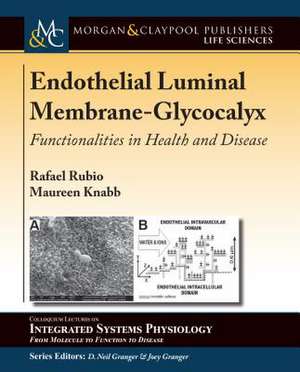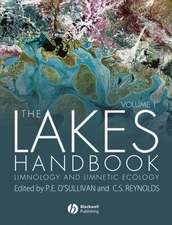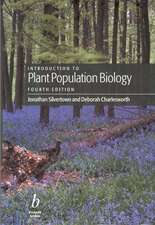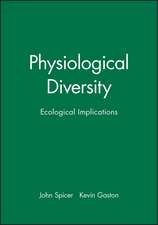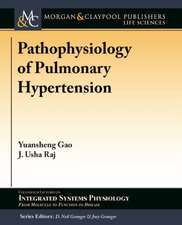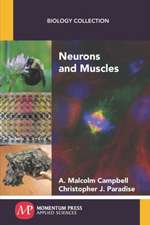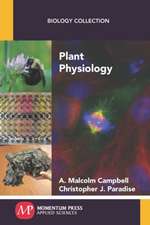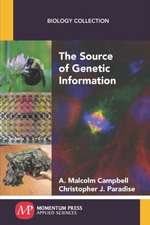Endothelial Luminal Membrane-Glycocalyx
Autor Rafael Rubio, Maureen Knabb Editat de D Neil Grangeren Limba Engleză Hardback – 2 noi 2017
| Toate formatele și edițiile | Preț | Express |
|---|---|---|
| Paperback (1) | 484.13 lei 43-57 zile | |
| Morgan & Claypool Life Sciences – 2 noi 2017 | 484.13 lei 43-57 zile | |
| Hardback (1) | 530.85 lei 43-57 zile | |
| Morgan & Claypool – 2 noi 2017 | 530.85 lei 43-57 zile |
Preț: 530.85 lei
Preț vechi: 624.53 lei
-15% Nou
Puncte Express: 796
Preț estimativ în valută:
101.61€ • 110.41$ • 85.41£
101.61€ • 110.41$ • 85.41£
Carte tipărită la comandă
Livrare economică 21 aprilie-05 mai
Preluare comenzi: 021 569.72.76
Specificații
ISBN-13: 9781615047635
ISBN-10: 1615047638
Pagini: 174
Dimensiuni: 196 x 241 x 14 mm
Greutate: 0.52 kg
Editura: Morgan & Claypool
ISBN-10: 1615047638
Pagini: 174
Dimensiuni: 196 x 241 x 14 mm
Greutate: 0.52 kg
Editura: Morgan & Claypool
Notă biografică
Rafael Rubio is an emeritus professor of physiology and biophysics at the University of Virginia (1969-1996) and the Universidad Autonoma de San Luis Potosi in Mexico (1996-2015). He was born in Querétaro, Mexico, a beautiful Spanish colonial city regarded as a World Heritage Site. Being a child and because of a civil war, his family migrated to Mexico City where he grew up and did his undergraduate work. By serendipity he became interested in science at 16 years old when he found a job working a few hours in a physiology laboratory cleaning and organizing. This laboratory was at the National Institute of Cardiology in Mexico, headed by Dr. Arturo Rosenblueth, previously at Harvard University and Dr. Walter B. Cannon was a visiting professor. Young Rubio was assigned to assist Dr. Cannon in his experiments during which Cannon taught him neuroanatomy, surgical procedures, physiological principles, and a sense of humanity. Both Dr. Rosenblueth and Dr. Cannon as well as the lab atmosphere aroused Dr. Rubio's interest in science.
With a meager salary, he remained working at the institute for several years, acquiring practical and conceptual physiological experience, and, as a result, the industrial company Syntex of Mexico offered him a better paying job in their Research Division. Three years later, he decided to leave behind applied science and a good salary, went back to performing basic research at the Institute of Cardiology, was given his own laboratory, and ultimately published 25 papers. In 1964, a fortuitous visit by Dr. Robert M. Berne to his laboratory in Mexico City resulted in a fellowship to join the Physiology Graduate Program at Western Reserve University. When Bob Berne, his mentor and friend, moved to Charlottesville to be the chairman of the Department of Physiology at the University of Virginia, Rafael joined him. Dr. Rubio received his doctorate in 1968, was appointed to the faculty in 1969, taught cardiovascular physiology to medical students, mentored numerous graduate students and postdoctoral fellows in his lab, and left the university in 1996.
During the last few years at the University of Virginia, he investigated the properties of the luminal endothelial coronary membrane glycocalyx and he decided to return to his native Mexico to make a difference. He joined the faculty of the School of Medicine of the Universidad Autonoma de San Luis Potosi as a professor of cardiovascular physiology. Despite retiring from UASLP in 2015, he continues to write, review grant proposals, and deliver invited presentations internationally.
With a meager salary, he remained working at the institute for several years, acquiring practical and conceptual physiological experience, and, as a result, the industrial company Syntex of Mexico offered him a better paying job in their Research Division. Three years later, he decided to leave behind applied science and a good salary, went back to performing basic research at the Institute of Cardiology, was given his own laboratory, and ultimately published 25 papers. In 1964, a fortuitous visit by Dr. Robert M. Berne to his laboratory in Mexico City resulted in a fellowship to join the Physiology Graduate Program at Western Reserve University. When Bob Berne, his mentor and friend, moved to Charlottesville to be the chairman of the Department of Physiology at the University of Virginia, Rafael joined him. Dr. Rubio received his doctorate in 1968, was appointed to the faculty in 1969, taught cardiovascular physiology to medical students, mentored numerous graduate students and postdoctoral fellows in his lab, and left the university in 1996.
During the last few years at the University of Virginia, he investigated the properties of the luminal endothelial coronary membrane glycocalyx and he decided to return to his native Mexico to make a difference. He joined the faculty of the School of Medicine of the Universidad Autonoma de San Luis Potosi as a professor of cardiovascular physiology. Despite retiring from UASLP in 2015, he continues to write, review grant proposals, and deliver invited presentations internationally.
